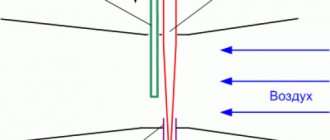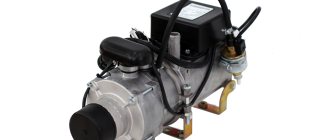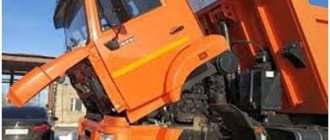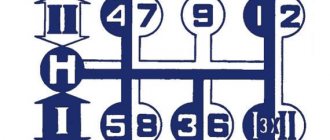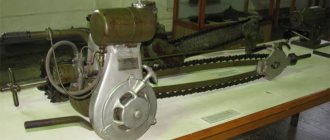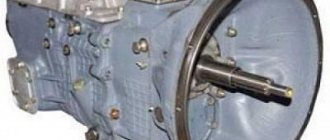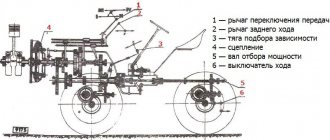Principle of operation
From the tank, through a coarse filter, using a low-pressure fuel pump, fuel flows through a fuel line first into the fine filter, and then to the inlet of the injection pump. Torque is transmitted from the engine crankshaft to the fuel pump, or rather to the cam shaft, which in turn drives the pushers. The pushers press on springs, which lift the plunger. The plunger closes the intake valve, fuel is supplied to the injectors, which spray it into the cylinders. The cam shaft, turning further, lowers the plunger, thereby opening the flow of fuel into the injection pump and the process repeats.
It seems like nothing is complicated, however, this is not entirely true. Any injection pump is a very complex mechanism, the basis of which is plunger pairs. They are made with very high precision. One such pair consists of a cylinder and a piston, which moves and creates high pressure in the system.
The fuel injection pump of the Kamaz 740 engine is a V-shaped device, each half of which contains 4 plunger pairs. At the bottom of the pump housing there is a cam shaft, to which torque is transmitted from the crankshaft. Cams on the shaft transmit translational motion to the pistons of each pair. The operation of the injection pump pistons is strictly synchronized with the operation of the engine pistons using spring pushers.
The design of each plunger pair has several valves, both inlet and outlet, and special grooves for removing excess fuel. The directions of fuel flow are controlled by special automatic valve mechanisms.
Basic rules for operating a car. Frequently performed repairs
It is clear that repairs are aimed, first of all, at preventing more serious breakdowns.
This kind of preventive measures also includes timely replacement of all working fluids. Clear. that lubricants and coolants must be selected in strict accordance with the existing recommendations of the car manufacturer. Leaks in the cooling system, malfunctions of valves and gaskets of the tank must be eliminated immediately after they are detected. Otherwise, all this can lead to cavitation damage to the block and liquid pump.
And, say, do-it-yourself repair of a Kamaz engine may be required if the pressure warning light in the lubrication system comes on. In this case, it is undesirable to continue driving until the fault is found and corrected. Using a machine with a leaky intake tract can also lead to premature engine failure.
To avoid cracks in the cylinder head mounting bosses, it is necessary to reliably isolate the threaded holes for the bolts from the ingress of dirt or liquid.
It is especially important to carry out such insulation if work is planned to replace engine heads
Sometimes repairs may require welding work.
In this case, it is very important to check that the battery is disconnected. You also need to remove the positive contact from the generator
As for the ground wire of the welding machine, it should be connected close to the weld.
As you know, repairs will be performed less frequently if the vehicle is provided with proper operating conditions. However, there are also recommendations on how to behave with a faulty car:
- If a coolant leak occurs while driving, the cooling system can be topped up with water. You should know that this measure is temporary. You can use this coolant to get to the repair site,
- If the machine is moved on roads with liquid mud, then it is necessary to periodically flush the radiator surface with water under pressure. This will allow you to avoid such procedures as repairing truck radiators. In order to carry out such washing, you need to raise the cabin. Be careful not to spray water on the generator.
- towing a car with the engine not running must necessarily include an operation to remove the driveshaft. This will help delay the repair of the Kamaz gearbox, because otherwise you will be provided with scuffing of the bearings of the secondary shaft gears in the gearbox.
Maintenance intervals
As already mentioned, the importance of preventive examinations cannot be underestimated. After all, thanks to this, you can avoid such manipulations as repairing fuel injection pumps, and you can also insure yourself against unpleasant breakdowns while driving
You need to perform a daily inspection of the main parts and components. This inspection includes checking the level of working fluids, as well as several other manipulations:
- checking the condition of the steering drive,
- checking the operation of all brake systems,
- checking the condition of wheels and tires.
In order to ensure trouble-free operation of all components, scheduled checks are carried out. Their frequency is twice a year. Such technical inspections are called seasonal maintenance and are intended to prepare the car for operation in winter and summer, respectively.
Possible malfunctions in the operation of the injection pump and their repair
In the fuel pump of the Kamaz 740 engine, high pressure is created due to the very tight fit of the piston in the cylinder of the plunger pair. If there is any violation of this density in the fuel system, the pressure drops and the engine may not start at all or may not run smoothly or intermittently. Long-term and trouble-free operation of the injection pump is primarily ensured by high-quality diesel fuel. For diesel engines, this is one of the main conditions for successful operation. Be careful when choosing the gas station where you refuel.
In order for the KAMAZ engine and fuel injection pump to work properly and for a long time, carry out all the necessary routine maintenance work on their maintenance in a timely manner, and special attention should be paid to replacing fuel filters, both coarse and fine cleaning. Try to buy original consumables from official dealers or authorized service centers.
Like any mechanism, the fuel injection pump has its own resource, which in any case will wear out over time. But Kamaz engineers have developed a repairable unit that can be restored by replacing worn parts. But the high-pressure fuel pump should be repaired at specialized stations that are equipped with a test bench for testing the fuel system under pressure. Such equipment will help identify both obvious and hidden faults. After repairs, the fuel injection pump must undergo a series of bench tests and fine-tuning with fuel injectors.
The main reasons for fuel injection pump failure
- Water in the fuel system . There may be several reasons for the appearance of water in the system: poor quality or worn fuel filter; a large percentage of water in diesel fuel; the seal of the fuel line is broken due to which condensation forms inside on the tubes.
- Mechanical impurities in fuel . Impurities can again appear due to poor fuel filters. It is also recommended to periodically clean the fuel tank from wax formations, etc. sediments.
- Poor lubricating properties of diesel fuel . The reason for this may lie in the use of uncertified additives. Do not fall for advertising and do not add anything unnecessary to the fuel that is not recommended by the manufacturer.
- Fuel line not sealed . In this case, there is a constant leak of air into the system, which increases the coefficient of friction in the plunger pairs, which leads to their rapid wear.
The most common faults
- Uneven fuel supply . The reason most likely lies in a damaged plunger pair. It is also recommended to check the fuel pump valves, as well as the operation of the injectors.
- Increased fuel consumption . The reason is simple - damage to the fuel line.
- Injection is delayed . The problem may lie in the pushrod adjusting bolt or in a damaged cam shaft.
Video describing in detail the operation of the fuel system of the Kamaz 740 engine.
Fuel supply adjustment
Diesel Fuel Information
Repair of KamAZ hydraulics
Depending on the conditions of use, according to GOST 305-82, the following grades of diesel fuel are established: L (summer), 3 (winter) and A (arctic). Their choice depends on the time of year and climatic conditions in the area of application.
Fuel L is used at air temperatures of 0 °C and above;
3 - at ambient air temperature - 20 °C and above (if the pour point of the fuel is not higher than - 35 °C), - 30 °C and above (if the pour point of the fuel is not higher than - 45 °C);
A - at ambient temperature - 50 °C and above.
The pour point of winter fuel corresponds to the last digit in its designation.
Summer fuel is more viscous; at subzero temperatures it releases paraffin in the form of flakes, and at 10 °C it loses its fluidity.
The last digit in the designation of summer diesel fuel characterizes the flash point.
The sulfur content in fuel characterizes its corrosive properties.
Depending on the sulfur content, diesel fuels are divided into two subgroups: with a sulfur mass fraction of no more than 0.2% and with a sulfur mass fraction of no more than 0.5% (for grade A fuel no more than 0.4%). Thus, fuels of the second subgroup contain approximately twice as much sulfur.
For KamAZ engines, fuel of both subgroups can be used, since they use motor oil with an additive that reduces the harmful effects of sulfur.
Let's look at examples of designation of diesel fuels:
L-0.2-40 GOST 305-82 - summer fuel, sulfur content up to 0.2%, flash point 40 ° C;
Z-0.5 minus 35 GOST 305-82 - winter fuel, sulfur up to 0.5%, pour point -35 ° C;
A-0.4 GOST 305-82 - arctic fuel, sulfur up to 0.4%.
One of the important indicators characterizing diesel fuel is flammability.
The fuel injected into the cylinder does not begin to burn immediately, but after some time, called the ignition delay period.
The longer the delay, the more fuel accumulates at the time of ignition and the faster the pressure in the cylinder subsequently increases. This leads to shock loads on the parts and is accompanied by metallic knocks (“hard” work).
The degree of “hardness” of a diesel engine depends on the ignition properties of the fuel and is characterized by the cetane number. The larger it is, the shorter the auto-ignition delay period, the easier the engine starts and the “softer” its operation.
Diesel fuels L, 3 and A have cetane numbers of at least 45.
How to remove the injection pump
- disconnect the manual control cables for the engine stop lever and the governor control lever,
- remove the fuel control rod,
- disconnect all fuel supply pipelines to the pump, outlet and drainage pipelines and the pipeline from the fine fuel filter,
- disconnect the oil supply pipe to the pump and the oil outlet pipe,
- unscrew the coupling bolt of the front flange of the driving half-clutch and the two bolts of the driven half-clutch (in order to unscrew the bolts conveniently, you need to turn the crankshaft through the clutch housing hatch),
- disconnect the spark plug fuel lines,
- remove the high pressure fuel lines,
- disconnect the tube that supplies air to the auxiliary brake working cylinder,
- unscrew the four bolts that secure the injection pump,
- remove the pump itself.
Ignition installation for KamAZ Euro-2
This car model has a diesel 8-cylinder V-shaped engine. This model has increased sensitivity to changes in the ignition timing angle.
You can set the ignition on KamAZ Euro-2, you can use the recommendations for KamAZ Euro-1, but at the final (last) stage you need to perform the following operations:
- lift the flywheel lock
- change position ninety degrees
- lower into the shock absorber bushing
- install the mudguard and secure it
- return the cabin to its original position
- lift the clamps to the upper position.
Read more: Honda oil analogue 0w20
There is a statement by experts that the optimal ignition timing is achieved when the mark is aligned with the edge of the index arrow.
Disassembly procedure
- Unscrew the screws securing the rear cover of the speed controller and remove the cover assembled with the low-pressure pump;
- remove the automatic fuel injection advance clutch using tool I-801.16.000. First, unscrew nut 2 (Fig. a) securing the coupling. To do this, insert screwdriver 4 into the groove of the nut and, holding clutch 1 from rotating, use wrench 3 to unscrew the nut. Then, screwing puller 5 into the coupling (Fig. b), remove the coupling;
Fig. 2 – Removing the coupling
- unseal and unscrew the screws securing the protective casings of the injection pump sections and remove the casing;
- Unseal and unscrew the bolts securing the top cover of the regulator and remove the cover;
- take out the axis of the regulator lever and remove the regulator lever with the weight clutch lever, clutch, regulator spring and spring lever;
- remove the retaining ring and weight holder assembly;
- unscrew the rack plugs, remove the rack bushings, then the racks themselves, having previously unlatched them;
- unscrew the nuts securing the injection pump sections, remove the lock washers of the section fittings and remove the injection pump sections and plunger pushers;
- unscrew and unscrew the nuts and, using a puller I-801.26.000, remove the eccentric of the low-pressure pump drive, the drive gear of the regulator and the intermediate gear;
- remove the second bearing from the idler gear axis;
- knock out the keys from the toe and shank of the cam shaft, remove the rear bearing cover, remove the cam shaft assembly with bearings and remove the front bearing cover;
- using the puller I-801.30.000, remove the bearings from the cam shaft;
- Disassemble the fuel injection pump sections and the low-pressure fuel priming pump using tool I-801.20.000. To press out the discharge valve of the fuel injection pump section, use tool I-801.21.000.
Setting the ignition
Hi all! Today we will tell you how to adjust the fuel injection pump on a KamAZ with a 740 Euro 2 non-turbo engine, namely, set the fuel injection timing in the field without removing the pump. Usually, this need arises after replacing the plates when the Kamaz fuel injection pump drive breaks, when all the adjustments are completely lost, and you are on the highway and you urgently need to go on your journey. The injection moment is the beginning of the supply of diesel fuel to the cylinders when the piston reaches top dead center (TDC) with the intake closed. and release. valves At this moment, maximum air compression occurs, which can ignite the diesel fuel. We will adjust the Kamaz injection pump using a V-shaped pump YAZDA from the Yaroslavl plant with MOVT. Truck model KAMAZ 5511. Work is carried out at engine operating temperature. First of all, lower the flywheel lock (1). If this is impossible to do due to its souring, we disassemble it, clean it and lubricate it, now it will be as good as new. The adjustment is made at engine operating temperature. We take a knob of suitable sizes (length, thickness). On the flywheel there are crown-shaped projections with holes for turning it. We crawl up from below, insert the knob into the hole. swing and turn as the motor moves until it locks (2). This means that the compression stroke is set in the first cylinder, but the piston has not reached top dead center by about 25-30 degrees. In this case, the clamping screw of the high-pressure fuel injection pump drive with its head must point upward (3), and the flywheel lock will align. The next step in adjusting the Kamaz fuel injection pump will be to loosen the two bolts on the 17mm injection advance clutch (4). This procedure can be done at the very beginning. Next, unscrew the fuel pipe of the 1st cylinder (5). We completely remove the fuel from the recess of the plunger fitting (section). Use a screwdriver to move the injection pump together with the coupling all the way counterclockwise in the direction of the arrow (6), the cabin is on the right. Then, slowly and little by little (2-3mm), tapping the sector with the adjustment marks with a screwdriver, turn the coupling in the opposite direction (7) until the first drop of diesel fuel appears in the recess of the fitting (8). This will be our moment of injection. As soon as this happens, we fix and tighten everything, now you can start the car. If you don't succeed the first time, it's okay. Perform this operation until you get the desired result. It is not 100% recommended to focus on the marks located on the body and coupling. Use them as a basic guide. During operation, they could “move” from one place to another, or even be erased.
Signs of late injection on KamAZ
Fuel arrives after the piston passes the TDC compression stroke, that is, already at the beginning of the power stroke.
- White smoke from the exhaust pipe
- Weak traction
- Stutters when revving up
- Shaking at medium speeds when gently pressing the gas pedal
- Increased consumption of diesel fuel
- Overheat
Symptoms of early ignition
- Hard work of the internal combustion engine
- A ringing sound is heard during sudden throttle changes and under load. As the engine temperature rises, the noise becomes louder.
- No traction
- High consumption
After the completed operations, start the engine, give the gas sharply or increase the load. The ringing should disappear. This means you did everything right!
How to increase or decrease the fuel supply on a KamAZ
Before making this adjustment, clean the surface of the fuel injection pump cover and change the air and fuel filters.
- We remove the high pressure pump tube (pumping pumps), the muffler and the gas draft (9) with a 13mm wrench
- Unscrew the idle speed screw completely and press the throttle lever (10) against it.
- Unscrew the cover mounting bolts (11) in a circle by 10mm
- Use a screwdriver to pry off the cover (12) and remove it.
- Using a 22mm corrector nut, we eliminate the gap between the levers of the all-mode regulator (13) so that the slats reach their full value.
- Use a hexagon to unscrew the plug (14) located on the right along the machine.
- Let's take two 10mm wrenches: a socket and an open-end wrench. We hold the end one with our right hand and insert it where the plug was.
- Rozhkov turn the adjusting bolt (15) a quarter (1/4) turn, no more.
- For ourselves - we add. From ourselves - we reduce it.
skeleton
The frame of the Bosch pump contains the parts necessary for the functioning of the mechanism: pump sections, a shaft with cams, and a rotation impulse regulator. The material of manufacture is aluminum alloy, from which the intake and shut-off channels are cast, as well as voids for mounting the pump sections, bearing shaft, regulator drive gears, fuel inlet and outlet fittings. The flank end contains a regulator plug with a reduced pressure pump. The plug has a fitting through which the injection pump is lubricated under pressure.
A cover is placed on top of the empty frame, to which mechanisms are attached that control the number of revolutions of the regulator and the fuel section plate. A pipe with a valve in the form of a ball is installed in the front part of the frame. The product maintains diesel fuel pressure within 0.06 to 0.08 MPa. The bottom of the frame contains a void into which a shaft with cams is installed.
KamAZ high pressure fuel pump:
Peculiarities
After all the parts are aligned to the marks, you need to tighten the fixing elements and start the engine. The car should start without problems the first time. If the truck does not start or white smoke comes out of the exhaust system, then the alignment is not done correctly by 180 degrees. You will need to unscrew the required parts and rotate them 180° and restart the engine.
If there are no marks or there are unnecessary marks, it is advisable to place the elements approximately in the middle of the adjustment marks. To understand how to correctly set the ignition on a KamAZ, it is necessary to take into account the signs of late and early injection.
Speed control device
The KamAZ Euro 2 fuel injection pump design provides for the use of a speed control mechanism. The fact is that for stable operation of the power plant, a steady state is required. The parameter provides for constant rotation of the shaft, heating of the lubricant, etc. To achieve the indicators, the values of the torsion impulses and counter-motion impulses are equalized. Operation upsets the balance, since the applied force in the modes differs, as a result, the parameter values deviate from the required ones. The return of impaired indicators is possible thanks to adjustment. The process takes place manually (fuel pump rail), or using an automatic machine that regulates the frequency. The last element maintains the user-suggested shaft speed by changing the portion of diesel fuel taking into account the load in automatic mode.
KamAZ engines are equipped with a direct type control device, installed in the frame of the pump with adjustment on the plug.
- A device that sets the required value of the controlled variable;
- Device for perceiving an influencing quantity;
- Comparison device;
- Execution device;
- A device that actuates the regulator.
KamAZ frequency regulator:
Pump departments
The pump section dispenses and supplies diesel fuel to the nozzles. Each unit includes a frame, a plunger pair, a rotation sleeve, elastic elements of the plunger, a discharge valve and a pusher.
The frame is equipped with a flange that secures the section to the pump using studs. The pin holes are oval in shape; it is possible to adjust the uniformity of diesel supply to each compartment individually (turning clockwise reduces the supply, and vice versa). The plunger pair is directly involved in cutting off and transporting diesel fuel and consists of a sleeve and a plunger. The parts are precision made, the material is steel with the addition of chromium and molybdenum, followed by hardening and cooling with nitrogen. The plunger acts as a piston, has axial drilling and radial grooves that change the flow of diesel fuel. The precision pair of discharge valve and seat are made of steel, after the elements are hardened and cooled. Replacement of components is possible only as an assembly.
KamAZ injection pump cam shaft:
Is the injection angle adjusted correctly?
It is necessary to check the correct ignition settings by turning the engine on and off. If there are signs of incorrect engine operation, you must repeat the described steps until the desired result is obtained. Correct installation is indicated by the absence of extraneous noise and the speed at which the motor starts. You can verify correct operation by using the idle speed. The rotation speed should be 600 rpm. Do not forget about safety precautions while working. Make sure the fuel supply system is turned off and you have secured the vehicle.
What could be better for you and your car?! And the increase in your truck's fuel consumption will be felt quickly, the moment you make a quick visit to the gas station and pay the check. Keep an eye on the health of your iron “friend”!
How to reduce or add fuel. Adjustment features
In practice, it is advisable to carry out such work on a specialized stand. They are usually available only at specialized service stations, which will ask for a certain amount for the work. At the same time, sometimes small jobs can be done on your own, saving money and time.
If you need to increase the fuel supply to the KAMAZ 740 injection pump, then, first of all, you need to check the general condition of the system. We are talking about nozzles, valves, filters, which can become clogged due to the use of low-quality fuel or various contaminants entering the tank. Often, a simple replacement of filters is enough to normalize the amount of diesel fuel supplied to the injection pump and further into the engine.
The volume of supplied fuel is directly adjusted using a screw with a slot for a screwdriver. When turning it, it is necessary to remember, or better yet, write down the direction and angle of rotation to ensure the ability to “return” to previous settings if engine performance deteriorates. This option is more suitable for adjusting the fuel supply to the injection pump in the field or in a garage, where it is not possible to use specialized equipment.
AUTOMATIC CLUTCH
Automatic clutch
The automatic clutch is a centrifugal regulator. The drive shaft of the pump 1 is connected to the cam shaft of the fuel pump 16 not rigidly, but through a coupling 3 having the following device. At the end of the drive shaft 1 of the fuel pump (see Fig. 62), the driving coupling half 10 is secured. The driven coupling half 15 is secured with a key on the cam shaft of the pump. On two axes 13 of the driven coupling half 15, weights 11 are freely mounted. Springs 14 rest against the axles 13 with one end and the thrust pin 19 of the driving half of the coupling with the other. The drive shaft 1 of the fuel pump rotates in conjunction with the driving coupling half, which through the pins 19 presses on the inner curved surface loads 11. The weights through the axles 13 transmit rotational force to the driven coupling half 15
Automatic clutch
Rice. 42. Automatic fuel injection advance clutch: a - general view of the design; 6 - operation diagram; c - details;
1 — fuel pump drive shaft; 2 — drive flange of the pump drive shaft coupling half; 3 — drive flange fixing bolt; 4 - coupling bolt; 5 — pump drive shaft coupling half; 6 — washer of the pump drive shaft coupling half; 7 — coupling body; 8, 18 and 21 - oil seals; 9 — bushing of the driving coupling half; 10 — driving coupling half; 11- cargo; 12 — adjusting shims; 13 — load axis; 14 — load spring; 15 — driven coupling half; 16 - cam roller of the fuel pump; 17 — rubber ring; 19 — thrust pin of the drive half of the coupling; 20 - ring nut
As the number of revolutions of the crankshaft 7...increases, the weights 11, under the influence of centrifugal force, overcome the resistance of the springs 14 and diverge (position P), sliding their curved surface along the surface of the pins 19 of the drive half-coupling.
The distance between the axles 13 of the weights and the fingers 19 is reduced. As a result of this, the driven coupling half 15 rotates relative to the drive half at a certain angle. Pump cam shaft, rigidly connected to the coupling half
automatic clutch
As the engine speed decreases, the centrifugal force decreases, the weights converge, and the driven clutch rotates in the direction opposite to rotation.
The injection advance angle decreases. Operating in this way, the automatic clutch, when starting at any engine speed, provides injection advance angles close to optimal.
It is known that an excessive increase in engine speed is dangerous because the resulting forces can cause increased wear and even breakdown. Therefore, carburetor and diesel engines are equipped with a regulator that does not allow the speed to increase above the set speed.
WATCH THE VIDEO


